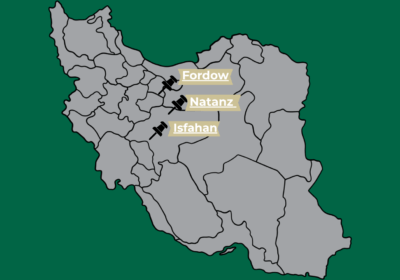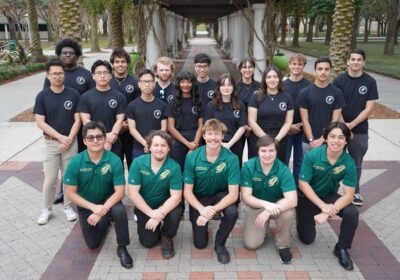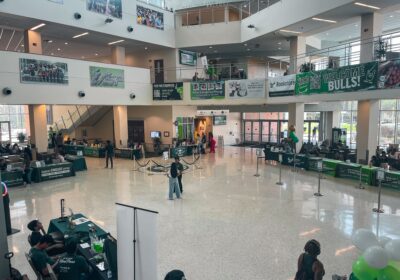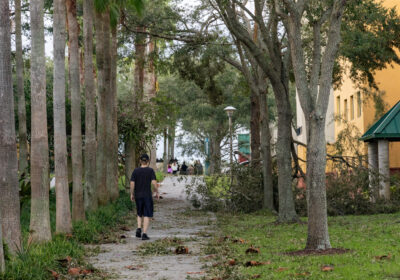USF student group fires rockets
As USF’s first rocket club successfully launched its first rocket thousands of feet into the air last month, members of the group said they are aiming even higher.
After years since its creation in 2010, the USF group Society of Aeronautics and Rocketry launched its first rocket, painted forest green and called the BULL-istic.
As the group intends to explore deep space, its past reaches as far as its rocket, with a history dating back to the Space Race during the Cold War.
Meanwhile, the rocket club wouldn’t have even been formed if its faculty adviser had his way.
In Spring 2010, Matthew Chrzanowski, a chemistry doctoral candidate, approached his Differential Equations professor Manoug Manougian with the hopes of creating USF’s first rocket club.
Manougian said he was initially hesitant to become the club’s faculty advisor.
“My students did this 50 years ago,” Manougian told Chrzanowski. “So what’s new now? Do you just want to launch rockets? You can buy one. What do you learn from that? Nothing.”
Eventually, the group did form with the help of Manougian, and as SOAR’s rocket lifted into the air, the club reached new reached new heights — an altitude of 8,000 feet, to be exact.
***
Both Manougian and Chrzanowski have been interested in rockets most of their lives.
Chrzanowski, now president of SOAR, said he has been interested in launching rockets since the second grade. Growing up in Cleveland, Ohio, he said he rembered visiting NASA’s John Glenn Research Center and seeing the Mercury I capsule — the first vehicle to put a human into space.
Chrzanowski also recalled videos of rockets lifting into space, with astronauts in tow. When he was older, he said he started buying model rockets and launching them from backyards and sports fields.
Similarly, Manougian said his fascination with rockets began when he was 11. He said he read “From the Earth to the Moon,” an 1865 novel written by Jules Verne.
However, it was during the 1960s in Lebanon, a war-torn country geopolitically positioned between the United States and the Soviet Union during the height of the Cold War and the Space Race, that Manougian said he became involved with a rocket club, a club that would launch rockets it created funded with their own pocket money.
“I remember my wife asking me ‘What are we going to eat for dinner?’” he said. “And telling her I spent the money on rocket supplies.”
Beginning by teaching physics at Haigazian College, Manougian and the members of his then-rocket club became credited with making the first rockets in the Middle East, inspiring a documentary about him and the Haigazian rocket club called “The Lebanese Rocket Society,” which has been shown at international film festivals since.
Despite attracting interest by government officials at the time, even some who came to “ensure safety” and other spectators who called themselves cultural attachés, Manougian said rocket engineering “was strictly a hobby.” He said he later found out that some in attendance were KGB and CIA agents.
It was after hearing Manougian’s story that Chrzanowski said he wanted him as the club’s faculty advisor and mentor.
But Maougian thought he was done with rockets.
“When I left Beirut, I said ‘I’ve done what I wanted to do’,” Manougian said. “I wanted to move on and my love has been in teaching. It was a dream I had. I realized the dream.”
***
Manougian eventually agreed to be SOAR’s faculty advisor on one condition.
“I want you to come up with something that doesn’t use chemicals,” Manougian told Chrzanowski.
There were two reasons for an aversion to chemicals, Manougian said. Not only can chemicals be dangerous he said, but he also wanted students to be innovative in launching a rocket that is launched in a way atypical from most others.
“You have to come up with something new,” Manougian said. “Something agencies such as NASA, or the military in the U.S. can use that will be different than what they’re using right now.”
Since the club’s launch in 2010, the club members had focused on building electromagnetic launch systems that would avoid the use of chemicals.
They consulted with engineers at NASA who said current technology would not allow them to construct an electromagnetic launch system. So, the club went back to the drawing board, settling on propellant-powered ignition.
“There is so much energy around us,” Manougian said. “We have an atomic bomb from a tiny, little particle. Someone was able to transform that into such energy that you can wipe out a whole city. They could use atomic energy for destructive purposes … These young kids are going to be able to come up with some mechanism to use that energy that’s all around us for space travel — for good.”
Throughout the past year, the group spent time assembling the rocket and retrofitting the painted fiberglass fuselage with deployable parachutes and instruments to record data of the flight. In total, the rocket cost $1,000 to build.
On the morning of Dec. 21, SOAR gathered in a Plant City field to launch their rocket. As it soared through the sky, all parachutes deployed as intended and the rocket reached a height of 8,000 feet.
Though they were unable to be completely free of chemicals, Chrzanowski said the reduction in chemical usage was progress.
“Our goal is to launch a rocket into space and carry a satellite, and put it into orbit,” Chrzanowski said. “Seeing the way our team came together really gives me a lot of inspiration and hope, for us to achieve great things in the future.”







